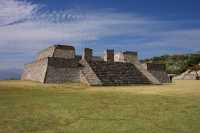Aztec Temples
Aztec temples were called, by the Mexica people of the empire, Teocalli - god houses. The priests of the Aztec religion went to these temples to worship and pray, and make offerings to the gods to keep them strong and in balance.

Identifying the Aztec temples has been a tricky job at times. It's been easy to simply assume that large, monumental structures such as pyramids are all either palaces or temples, but that may not be the case. Still, we do have a good understanding of what happened in the religious areas and how the many of the buildings looked hundreds of years ago.
Often a whole area of a city would be dedicated to religious activities. Some monuments would be made to specific gods. Some were built for specific celebrations. The buildings you probably associate with the Aztec religion are the great pyramids. These were four sided, stable structures that can withstand the earthquakes that are common in the area. These would have stairs up one side, and a flat top, often with a shrine on the top. Let's take a look at some of the Aztec temples specifically:
Templo Mayor
Height: 60m/197ft
The gods: Huitzilopochtli and Tlaloc
Distinctives: A double temple
Completed: 1497
Materials: Built of stone and covered with stucco and polychrome paint
Templo Mayor was a part of the sacred area of the city of Tenochtitlan, now Mexico City. It was only one of perhaps 75-80 buildings which included other pyramids, ornamental walls, gathering places, shops and, of course, bathrooms. Since the city was build on swampy ground, the temples would often sink and needed to be repaired and built up over the years.
The temple itself was the main religious building of the capitol city, and it had two shrines on the top - one to Huitzilopochtli and one to Tlaloc. Huitzilopochtli (Hummingbird of the South) was the patron god of the Mexica people, the one who led them to Tenochtitlan in the first place. He was the god of the sun and war. Tlaloc was the god of rain and fertility. Both gods required constant human sacrifice. During the final phase of construction, thousands were sacrificed.
Many, many rituals were done at the temple - human sacrifice, of course, is the most well known. But there were many more, such as the private ritual blood-letting, burning of copal (a tree resin), and the music of worship. This Aztec temple represented the Hill of Coatepec, where the Mexicas believed Huitzilopochtli was born.
See a photo of Templo Mayor at the bottom of the Aztec religion page.
The Pyramids of the Sun and Moon (Teotihuacán)

The moon pyramid at Teotihuacán.
I took this picture from the top of the sun pyramid.
Height: 65m/215ft (sun) 42m/138ft (moon)
The gods: Tlaloc and Chalchihuitlicue (or the Sun and the Moon)
Distinctives: The pyramid of the sun is the 3rd largest in the world
Covering: At their peak, it's believed the pyramids were plastered and painted bright red
Teotihuacán was not originally built by the Aztecs. In fact, it's height of power had been almost 1000 years earlier, and may have been built another 1000 years or more before that. The Mexicas were in awe of the ancient people and their city, although they knew very little about it. They believed this to be the birthplace of the most recent creation, where the new sun had been born.
The pyramid to the sun was built on a lava tube cave (a shrine here may be the original reason for the settlement). Chalchihuitlicue was the goddess of lakes and streams, and Tlaloc was the god of fertility and rain. Though built as temples, a burial site has been found as a part of one.
Though not built by the Aztecs, it was considered a sacred site. The Aztecs used ideas from the architecture here, and used objects from the city in their rituals. Read lots more about Teotihuacan here.
Other Aztec Temples
There are numerous Aztec temples, both in these cities and others. The Great Pyramid of Cholula is the largest pyramid by volume in the world, and the largest monument ever constructed. Inside 8km/5mi of tunnels have been dug to investigate its secrets. The Cholula temple has its own page.
Another temple featured on this site is the great pyramid (temple) of Teopanzolco.
The ruins at Teotenango also contain temples. Temples were built in each region of a city, and there were also mountain temples - often carved right out of the side of the mountain. It is believed that as late as the 19th century a child was sacrificed at one of these Aztec temples.
Of course, many of the so-called Aztec temples were temples that existed before the Aztec empire did. Many peoples and cities were conquered and forced to pay tribute, becoming a part of the empire. One city like this was Xochicalco - a pyramid at the top of this page is from Xochicalco.
Many Aztec temples and other ruins are mapped at Google here. If you look at the "related maps" at the bottom of the page, you'll find even more maps in various categories.
The Aztec temples are still major religious destinations today. Some now have Roman Catholic Churches built over top, others are still just pyramids where people come to pray to the gods, or come, they believe, to gain some special power.